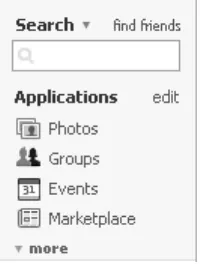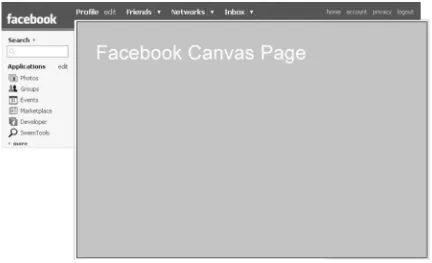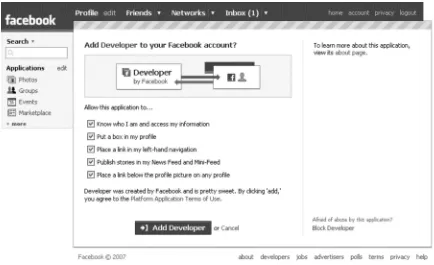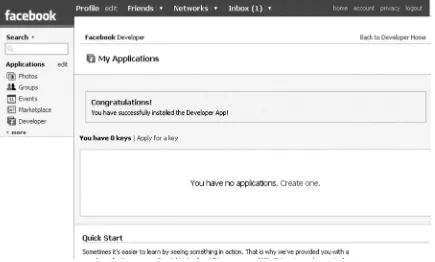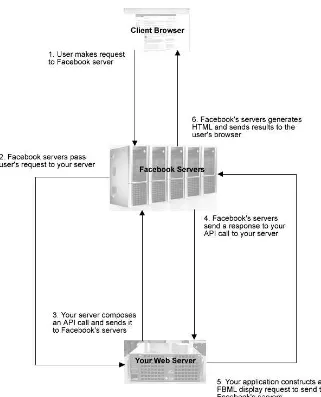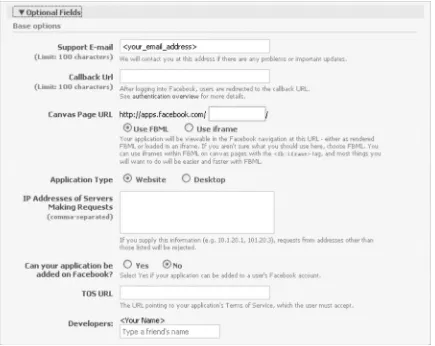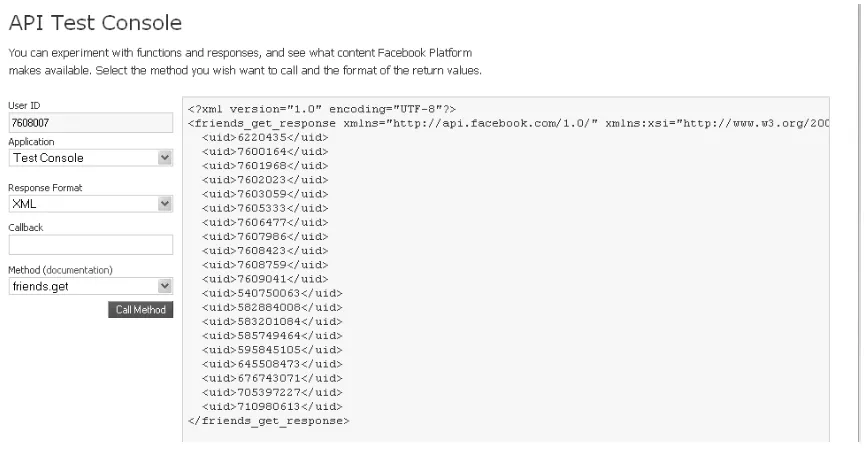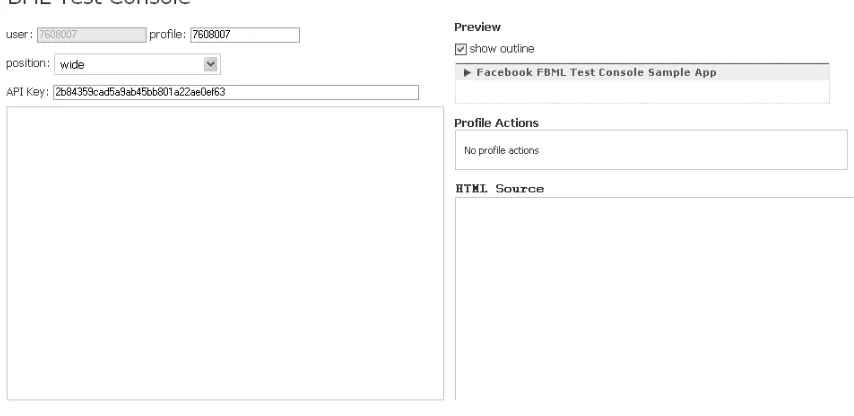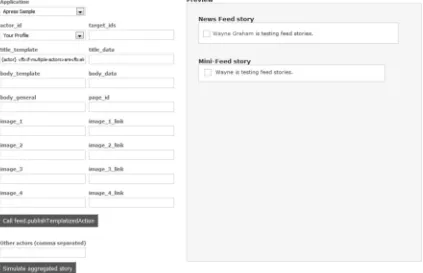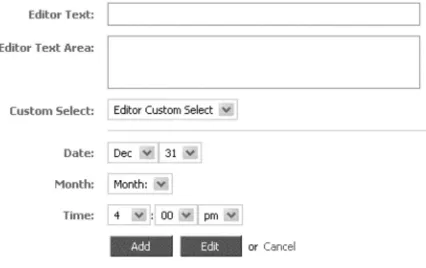Wayne Graham
Facebook API
Developers Guide
CHAPTER 1
Introducing the Facebook Platform
. . .1
CHAPTER 2
Getting Ready for Facebook Application Development . . . 9
CHAPTER 3
Learning Facebook Platform Fundamentals
. . .31
CHAPTER 4
Building a Facebook Application, Start to Finish. . . .
71
CHAPTER 5
Going Further with Your Application
. . . .129
137
PAGES
Facebook API
Developers Guide
All rights reserved. No part of this work may be reproduced or transmitted in any form or by any means, electronic or mechanical, including photocopying, recording, or by any information storage or retrieval system, without the prior written permission of the copyright owner and the publisher.
ISBN-13: 978-1-4302-0969-0 ISBN-10: 1-4302-0969-0 eISBN-13: 978-1-4302-0970-6
Printed and bound in the United States of America (POD)
Trademarked names may appear in this book. Rather than use a trademark symbol with every occurrence of a trade-marked name, we use the names only in an editorial fashion and to the benefit of the trademark owner, with no intention of infringement of the trademark.
Lead Editor: Ben Renow-Clarke
Technical Reviewer: Mark Johnson
Editorial Board: Clay Andres, Steve Anglin, Ewan Buckingham, Tony Campbell, Gary Cornell, Jonathan Gennick, Kevin Goff, Matthew Moodie, Joseph Ottinger, Jeffrey Pepper, Frank Pohlmann, Ben Renow-Clarke, Dominic Shakeshaft, Matt Wade, Tom Welsh
Senior Project Manager: Tracy Brown Collins
Copy Editor: Kim Wimpsett
Compositor: Richard Ables
Cover Designer: Kurt Krames
Manufacturing Director: Tom Debolski
Distributed to the book trade worldwide by Springer-Verlag New York, Inc., 233 Spring Street, 6th Floor, New York, NY 10013. Phone 1-800-SPRINGER, fax 201-348-4505, e-mail [email protected], or visit
http://www.springeronline.com.
For information on translations, please contact Apress directly at 2855 Telegraph Avenue, Suite 600, Berkeley, CA 94705. Phone 510-549-5930, fax 510-549-5939, e-mail info//www.apress.com.
Apress and friends of ED books may be purchased in bulk for academic, corporate, or promotional use. eBook ver-sions and licenses are also available for most titles. For more information, reference our Special Bulk Sales—eBook Licensing web page at http://www.apress.com/info/bulksales.
The information in this book is distributed on an “as is” basis, without warranty. Although every precaution has been taken in the preparation of this work, neither the author(s) nor Apress shall have any liability to any person or entity with respect to any loss or damage caused or alleged to be caused directly or indirectly by the information contained in this work.
■WAYNE GRAHAMis the emerging technology and digital library coordinator at the Earl Gregg Swem Library at the College of William and Mary. He has a bachelor’s degree in history from the Virginia Mili-tary Institute and a master’s degree in history from the College of William and Mary. While a graduate student, he worked with the Colonial Williamsburg Foundation on a project digitizing the foundation’s collection of books, manuscripts, and research reports and discovered a love of all things technical. After funding for the project ran out, Wayne took a position at William and Mary where he works to find new ways to integrate new technology into the library and helps scholars from across the country develop online projects for research.
Wayne currently resides in Williamsburg, Virginia, with his wife, Anna; daughter, Stella; and two crazy dogs, Nikki and Jasper. In his “free” time, Wayne enjoys reading, playing almost any video game, and spending quality time with his family. If you’re so inclined, you can add Wayne as a friend on Face-book.
■MARK JOHNSONis a lieutenant in the United States Navy and currently a senior instructor at the U.S. Naval Academy. He has a bachelor’s degree from the Naval Academy and a master’s degree in computer science from George Washington University.
When not working, Mark enjoys spending time with his wife, Lori, and their friends.
About the Technical Reviewer
Introducing the Facebook
Platform
Facebook (http://www.facebook.com) has grown phenomenally over the past several years from an Ivy League social web application to the second largest social web site on the Internet. The creators of Facebook have done an impressive job focusing their social software on the college demographic. In a natural progression of the social network, Facebook recently extended its network by developing a platform for developers to create new applications to allow Facebook users to interact in new and exciting ways.
What Is Facebook?
In 2007, Facebook launched its own platform for application development. The platform consists of an HTML-based markup language called Facebook Markup Language (FBML), an application programming interface (API) for making representational state transfer (REST) calls to Facebook, a SQL-styled query language for interacting with Facebook called Facebook Query Language (FQL), a scripting language called Facebook JavaScript for enriching the user experience, and a set of client programming libraries. Generically, the tools that make up the Facebook platform are loosely called the Facebook API.
By releasing this platform, Facebook built an apparatus that allows developers to create external applications to empower Facebook users to interact with one another in new and exciting ways—ways that you, as a developer, get to invent. Not only can you develop web applications, but Facebook has also opened up its platform to Internet-connected desktop applications with its Java client library. By opening this platform up to both web-based and desktop applications and offering to general users the same technology that Facebook developers use to build applications, Facebook is positioning itself to be a major player in the future of socio-technical development.
A Brief History of Facebook
earlier, a bright young programmer named Mark Zuckerberg matriculated at Harvard University. The year in which MySpace launched, Zuckerberg and his friend Adam D’Angelo launched a new media player, called Synapse, that featured the Brain feature. Synapse’s Brain technology created playlists from your library by picking music that you like more than music than you don’t. Although this type of smart playlist generation is common in today’s media players, at its launch, it was an innovation. Synapse’s launch was met with positive reviews, and several companies showed interest in purchasing the
software; however, ultimately no deals were made, and the media player never took off. Unfortunately (or fortunately, depending on your perspective), one of Zuckerman’s next projects created quite a bit more controversy. He created Facemash.com, a variant of the HOTorNOT.com web site for Harvard students. To acquire images for the web site, Zuckerberg harvested images of students from the many residence hall web sites at Harvard. Because Zuckerberg was running a for-profit web site and had not obtained students’ permission to use their images, Zuckerberg was brought before the university’s administrative board on charges of breaching computer security and violating Internet privacy and intellectual property policies. Zuckerberg took a leave of absence from Harvard after the controversy and then relaunched his site as a social application for Harvard
students in 2004. The viral nature of the web site allowed it to grow quickly, and a year later Zuckerberg officially withdrew from Harvard to concentrate his efforts on developing what was first known as thefacebook.com.
Relaunched as Facebook in 2005, the social network quickly expanded to the rest of the Ivy League. Soon after, Facebook expanded dramatically across university and college campuses across the nation. Facebook’s focus on the college and university demographic helped catapult it into what any marketing manager will tell you is the most difficult demographic to crack, the 18–24 young adult market.
To keep its growing momentum, Facebook opened its doors to nonacademic users for the first time in 2007. Since this time, Facebook has grown to be the second largest social network with more than 30 million users. And with any growth comes opportunities both for the company and for its users.
The Elements of the Facebook Platform
As stated previously, the Facebook platform consists of five components: a markup language derived from HTML (Facebook Markup Language), a REST API for handling communication between Facebook and your application, a SQL-style language for interacting with Facebook data (Facebook Query Language), a scripting language
Facebook Markup Language
If you’ve ever developed in ColdFusion or JSTL (or other tag-based programming language), you’ll find working with the platform’s Facebook Markup Language (FBML) very natural. If you’re new to tag-based programming, just think of FBML as fancy HTML tags, because each interaction starts and ends with a tag. However, to distinguish between HTML and Facebook commands, you prefix the tags with fb: as you would if you were using multiple DTDs/schemas in XHTML. By using the FBML tag set, Facebook abstracts a lot of complex code and makes many of the routine procedures almost effortless. For example, to add a link to your application’s help pages on your dashboard (the navigational tabs that go across the top), you simply need to add the following lines:
<fb:dashboard>
<fb:help href="help.php">Application Help</fb:help> </fb:dashboard>
REST API Calls
Facebook API calls are grouped into eight action categories. These calls are really wrappers for more sophisticated FQL interactions with the Facebook back end but are useful bits of code that speed up the development of your application. These calls include the following:
• facebook.auth provides basic authentication checks for Facebook users.
• facebook.feed provides methods to post to Facebook news feeds.
• facebook.friends provides methods to query Facebook for various checks on a user’s friends.
• facebook.notifications provides methods to send messages to users.
• facebook.profile allows you to set FBML in a user’s profile.
• facebook.users provides information about your users (such as content from the user’s profile and whether they are logged in).
• facebook.events provides ways to access Facebook events.
• facebook.groups provides methods to access information for Facebook groups.
Facebook Query Language
The Facebook Query Language (FQL) is a SQL-style language specifically designed to allow developers to interact with Facebook information. Facebook allows you to interact with nine separate “tables” to query information directly. You have access to the following:
• user
• friend
• group
• group_member
• event
• event_member
• photo
• album
• phototag
I’ll get into the specifics of the information you have access to in these “tables” later in the book, but suffice to say, Facebook exposes a lot of information to you for your
application. And, like most SQL implementations, some additional functions allow you to take a few shortcuts when you request user information:
• now() returns the current time.
• strlen(string) returns the length of the string passed to the function.
• concat(string1, string2,…, stringN) concatenates N strings together.
• substr(string, start, length) returns a substring from a given string.
• strpos(haystack, needle) returns the position of the character needle in the string
haystack.
• lower(string) casts the given string to lowercase.
• upper(string) casts the given string to uppercase.
SELECT name, pic FROM user
WHERE uid = 7608007
The previous snippet, when executed by the Facebook platform, will return a structure (in a format that you define in your call) with a URL to the image of the profile image for user 7608007. Calls like these are useful in giving you granular control of the information you get back from the API.
Facebook JavaScript
To minimize the threat of cross-site scripting (XSS) attacks, Facebook implemented its own JavaScript for developers who really want, or need, to use JavaScript in their applications. Facebook scrubs (removes) much of the JavaScript you can add to your application, but by
using Facebook JavaScript (FBJS) you can still enrich the user’s experience. Facebook formally released FBJS 1.0 in September 2007. If you’re well versed in JavaScript, you’ll pick this up quickly (or perhaps find it maddening). The following is a quick example of how you can provide a modal dialog box to your users:
<a href="#" onclick="new Dialog().showMessage('Dialog', 'This is the help message for this link');return false">Show Dialog Box</a>
When processed through the Facebook platform, a user will be shown the modal dialog box represented in Figure 1-1 after clicking the Show Dialog Box hyperlink. Not bad for a single line of code!
Client Libraries
The Facebook platform provides many tools to access information, but you are responsible for providing your own business logic through some other language. Facebook facilitates this through “official” client libraries for both PHP and Java that provide convenient methods to access the Facebook application. However, not everyone in the universe uses Java and PHP exclusively. To help the rest of the programmers who want to develop their own Facebook application, client libraries are available for the following languages:
• ActionScript
• ASP.NET
• ASP (VBScript)
• ColdFusion
• C++
• C#
• D
• Emacs Lisp
• Lisp
• Perl
• PHP (4 and 5)
• Python
• Ruby
• VB .NET
• Windows Mobile
Summary
In this chapter, I briefly went over what the Facebook platform is and outlined some of its technologies and capabilities. I also talked about how Facebook has grown to be the second largest social network on the Web. In the forthcoming chapters, I’ll get more into the specifics of what the different parts of the platform do and how these components work together to allow programmers to develop rich applications for Facebook users.
In the next chapter, you’ll work on setting up a new application from scratch, including setting up your server. There’s not much to set up before you start building your
Getting Ready for Facebook
Application Development
Keeping with its user focus, Facebook makes it easy to both set up and maintain
applications. Because your application doesn’t live on Facebook’s servers, you need to put certain things in place before you start developing. This chapter will cover setting up your environment so you can start coding your application. It will also cover some of the tools that Facebook provides you to help develop and debug your code.
Getting to know a new platform can be daunting, especially one that has so many facets like the Facebook platform. To help you get your feet wet with the different aspects of the platform, Facebook provides you with a couple tools that let you explore the core API functions, test your Facebook Query Language, and see how your Facebook Markup Language will look in the different areas of the Facebook site.
What’s Needed
To get up and running with developing an online Facebook application, you need to have three things in place:
• A valid Facebook account
• Access to a web server running a supported middleware language
• The client library for your particular middleware language
Creating a Facebook Account
Setting up a Facebook account is a simple process. If you don’t already have one, don’t worry; it’s free, and anyone can sign up to use Facebook. Just point your browser to
http://www.facebook.com, and click the Sign Up button (see Figure 2-1).
Figure 2-1. The Facebook sign-up screen
The form asks a few simple questions about you and will send you a confirmation e-mail to verify your e-e-mail address. After you confirm your account, you have the
opportunity to join a network. These networks are grouped by academic institutions, locations, and businesses and are at the core of Facebook’s social structure’s organization. Once you join a network, you are able to access information about the people in that network.
Understanding Facebook Layout and Terms
If you’re new to Facebook (or even if you’ve been using it for a while), it’s useful to
three-column layouts for different parts of its site with a header and footer containing global links. Except for the header and footer, users can edit their content layout. This is an
important design consideration, because depending on where your content is loaded on a user’s page, you need to take into account different widths.
On the far left of all pages, users have access to the different applications they have installed in the navigation bar. By default, only four appear (see Figure 2-2), so, depending on how many applications your user has, your application might not appear in their
navigation bar. Obviously, if you’re designing an application, you want folks to not only use it but to also have it in a convenient location on their Facebook pages.
Figure 2-2. The Facebook left navigation box
Figure 2-3. The Facebook canvas page
Another important page is the profile page. This is the page you see when you log on to Facebook. The layout on this page is slightly different from the canvas pages. There are still three columns, and the application navigation is still on the left. However, the content column (referred to as wide) has shifted to the far right, and it is separated from the
application navigation panel by what Facebook calls the narrow column. Because users can change the layout of their pages, it’s important that you have multiple displays for your application depending on the column in which it’s located.
Setting Up Your Server
Since you host your own Facebook application, there is some setup you need to do on your web space. If you don’t have a web site (or access to one) that runs PHP, Java, or one of the unsupported languages with a client library, you can use one of the free web hosts available. You will need a middleware application server to handle the business logic for your
You can download the client libraries for all languages from
http://developer.facebook.com/resources.php. If you’re using a *nix system (including OS X), you can simply do the following:
wget http://developers.facebook.com/clientlibs/facebook-platform.tar.gz tar zxvf facebook-platform.tar.gz
mv facebook-platform <path_to_web_location>
The previous snippet moves both the PHP 4 and PHP 5 libraries (along with the
Footprints sample application). The PHP 4 library is in the folder php4client, and the PHP 5 library is in the client folder. Most likely you will be working with one library or the other, so you really need to move only one of the folders to your server to work on your
application.
Note➡ Need some hosting? Joyent (http://www.joyent.com) recently partnered with Facebook to provide a free year of hosting for Facebook applications (http://joyent.com/developers/facebook). There is a waiting list, but it is a pretty good deal for a really good host. Other hosts that have a proven track record with Facebook apps include MediaTemple (http://www.mediatemple.net) and Dreamhost (http://www.dreamhost.com/). If you’re thinking smaller, you might want to try RunHosting
(http://facebook.runhosting.com) or 110MB (http://www.110mb.com). It’s good to look at a few and see which one offers the best fit for what you want to do. Many of these web sites also have free database hosting (usually MySQL), which is a great way to get up and running with Facebook application development.
Adding the Developer Application
Once you have an account and have set up a server environment, the next step is to add Facebook’s Developer application. Go to http://www.facebook.com/developers, and install the application.
Figure 2-4 shows the screen that users are presented with when installing a new
Figure 2-4. Facebook’s Developer application installation screen
Figure 2-5. Facebook’s Developer welcome screen
It’s important to keep up-to-date with the platform status because Facebook is adding information about new tags, changes to the terms of service (typically clarifying hazy areas), systemwide outages, and, perhaps most important, platform changes that have the potential to break your application. Like with most things in Facebook, you can subscribe to an RSS feed to help you keep up-to-date with these changes
(http://www.facebook.com/feeds/api_messages.php).
Understanding How Facebook Applications Work
Because you host your own application, it’s a good idea to go over how Facebookapplications actually work. Essentially, Facebook provides your application to users when it is requested through Facebook.
the response to construct a display call (in FBML) and passes that back to the Facebook server. Facebook processes this information and creates an HTML response to the user. Because of the constant passing of information between servers, there is an additional level of complexity that can complicate tracking down bugs. You also need to consider this constant interaction when developing your application because you don’t want to make unnecessary API calls that will slow down your application.
Creating a New Application
Now, with all that out of the way, let’s set up an application. At this point, you need to tell Facebook about your application. In the Facebook Developer application
(http://www.facebook.com/developers), click the Set Up New Application button, as shown in Figure 2-7.
Figure 2-7. Setting up a new application
The only required fields are the application name and the one confirming you have read the terms of service. However, to really do anything with an application, you will need to fill out the optional fields. Don’t worry—if you already set up an application and didn’t fill out these fields, you can change them by clicking the My Apps link in the Developer application.
Note➡ You need to remember that you can’t use the word face anywhere in your application name.
Because of this prohibition, you are precluded from using words such as surface and faceted as part of your
application name. A good thesaurus can help you get a bit more creative with your application names.
In the optional fields, you can fill out more information about how your application works (see Figure 2-8). Perhaps the most perplexing field here is the Callback URL field. This is the field that handles your actual application and lives in the server environment you’ve set up. For example, if you have a web site for your application at
Figure 2-8. Optional fields for Facebook application registration
The following are the optional fields:
Support E-mail: This is the e-mail contact for support questions for your application.
Callback URL: This is the URL of your actual application on your server. If you’ve set up an application on your server at http://fake.domain.com/facebook_app, that is your callback URL (you’ll sometimes see this referred to as the callback metaphor).
Application Type: Most likely this will be Website, but if you’re developing an
application in Java (using the official client library) or one of the unofficial libraries that won’t be accessed primarily on the Web, select Desktop.
IP Addresses of Servers Making Requests: This is a comma-separated list of servers able to make requests. If you need to lock down your application to a list of servers, this is where you add that information. Requests from other servers are then rejected. If you use this with an online application, the users will be presented with a fatal error in the response stating that an “Unauthorized source IP address” was used to access the application.
Can your application be added on Facebook?: An answer of Yes to this question will allow people to add the application to their account. If you select No, users will be able to use the application but won’t be able to add it to their accounts.
TOS URL: This is the URL to the terms of service for your application. If you use this, users must accept the terms of service before they can use your application.
Developers: Your name should appear in this field by default. If you’re working with others to develop your application, put their names there too.
Facebook Terms of Service Highlights
Terms of service are something a lot of folks skip over…which they shouldn’t. If you’re one of these people, please take some time to go over these documents because they’re there to save you some headaches in the long run. As with any terms of service agreement, there are certain prohibitions that you should be aware of in terms of what is, and is not, permissible. There have been some recent changes to the Facebook terms of service that are designed to clarify some of the gray areas in the guidelines, and these will most likely continue to change as unscrupulous people look for loopholes.
Using Facebook Tools
Facebook provides three important tools for learning and debugging Facebook applications in the Tools section of its Developers web site (http://developer.facebook.com/tools.php): the API Test Console, the FBML Test Console, and the Feed Preview Console. Because it’s good to have immediate feedback with your code and because it’s sometimes difficult to debug coding issues and determine whether the problem exists on your end (of course you would never code a bug!), we’ll start our adventure by looking at the test console for both the API calls and FBML.
API Tab
When you first arrive at the Tools page, you are presented with two tabs. The API tab has many of the API calls available to you so you can see what kind of data is being returned. I find it useful in my day-to-day programming to be able to see the data I expect to have returned in order to speed development.
For starters, let’s take a look at a simple call to return a list of your friends. Simply select the friends.get option for the Method field. This will return an XML structure with a root element of <friends_get_response>. You’ll also notice a couple of XML namespaces and a location for the schema. If you run into issues with the responses, remember how you’re getting them. If it’s XML, you might need to deal with the root XML attributes. The Facebook API Test Console (Figure 2-9) is a great place to click around and see what different calls will return. Not only can you switch between the different API calls, but you can also change response formats to see what you will get when you change the
Figure 2-9. Facebook API Test Console
XML
Here’s what the XML result looks like:
<?xml version="1.0" encoding="UTF-8"?>
<error_response xmlns="http://api.facebook.com/1.0/" xmlns:xsi="http://www.w3.org/2001/XMLSchema-instance" xsi:schemaLocation="http://api.facebook.com/1.0/ http://api.facebook.com/1.0/facebook.xsd"> <error_code>100</error_code>
<error_msg>Invalid parameter</error_msg> <request_args list="true">
<arg>
<key>uids</key> <value/>
</arg> <arg>
<key>fields</key> <value/>
</arg> <arg>
<value/> </arg> <arg>
<key>app_id</key>
<value>2227470867</value> </arg>
<arg>
<key>session_key</key>
<value>c50b22639edc8d2d0dd29357-7608007</value> </arg>
<value>facebook.users.getInfo</value> </arg>
<arg>
<key>api_key</key>
<value>0289b21f46b2ee642d5c42145df5489f</value> </arg>
<arg>
<key>call_id</key>
<value>1186452883.4263</value> </arg>
<arg>
<key>sig</key>
<value>28186e1be6ee4015119a992b638b694a</value> </arg>
</request_args> </error_response>
JSON
JSON uses a slightly different syntax to express the same information:
{"error_code":100,
"error_msg":"Invalid parameter", "request_args":[
{"key":"app_id","value":"2227470867"},
{"key":"session_key","value":"c50b22639edc8d2d0dd29357- 7608007"}, {"key":"v","value":"1.0"},
{"key":"format","value":"json"},
{"key":"method","value":"facebook.users.getInfo"},
{"key":"api_key","value":"0289b21f46b2ee642d5c42145df5489f"}, {"key":"call_id","value":"1186452905.8595"},
{"key":"sig","value":"b7e26b1f71aeffb448d26cdf89f32f6e"} ]
}
PHP
Here’s the PHP:
Exception Thrown: FacebookRestClientException Code: 100, Message: Invalid parameter
You can also try FQL in this box. This is a nice place to start inserting different FQL queries to see what is getting returned in different formats.
Here is a quick sample of FQL that queries Facebook for a link to my profile picture:
SELECT pic FROM user
WHERE uid = 7608007
You’ll notice the response format returns a single field in the <fql_query_response>
element:
<?xml version="1.0" encoding="UTF-8"?>
<fql_query_response xmlns="http://api.facebook.com/1.0/" xmlns:xsi="http://www.w3.org/2001/XMLSchema-instance" list="true">
<user>
<pic>http://profile.ak.facebook.com/profile5/1622/61/s7608007_3215.jpg</pic> </user>
</fql_query_response>
Or, if you prefer to get your responses in JSON, here’s the code:
[{"pic":"http:\/\/profile.ak.facebook.com\/profile5\/1622\/61\/s7608007_3215.jpg"}]
For PHP, here’s the code:
[0] => Array (
[pic] =>
http://profile.ak.facebook.com/profile5/1622/61/s7608007_3215.jpg )
)
These are all the responses from the same query, just in different response formats. What you’ll notice is that each of the formats returns the information in slightly different ways. The XML format is by far the most verbose and, depending on your environment, is something you might want to take into consideration as your calls to the Facebook platform become more complex. Let’s look at another FQL query:
SELECT first_name, last_name, hometown_location.state, status FROM user
WHERE uid = 7608007
This query will return to you my first and last name, my hometown state, and the status message I set on my home page. This is a basic query that returns a rather straightforward structure. I’ll get into some more advanced queries later where you can combine fields and use aggregate functions in FQL to decrease the amount of bandwidth you need to run your applications.
FBML Tab
The Facebook Markup Language is a powerful set of tags that abstracts some rather
complex code. Although Facebook will scrub (that is, remove) JavaScript you put into your code, it does allow you, through FBML markup, to use certain types of JavaScript code. There are two ways to do this. You can use the MockAjax framework, which you’ll find does much of the JavaScripting you need to do, or you can use Facebook JavaScript (FBJS) to let you do more advanced scripting.
FBML is a superset of HTML, utilizing many of the HTML tags but also adding its own special sauce to allow you to do some rather fun things. To test some of the features you might be considering before you deploy, it’s a good idea to see how your code renders when pushed through the Facebook platform.
Again, you can access this tool at http://developer.facebook.com/tools.php and click FBML Test Console. Once there, you’ll notice a slightly busier interface than the API Test Console (see Figure 2-10).
Figure 2-10. The FBML Test Console
The large panel on the left is where you can type (or paste) your HTML and FBML code and look at the differences in the output (displayed on the right side) for the different positions that you can place your display (narrow, wide, canvas, e-mail, notification, feed title, and feed body). Let’s take a look at a couple of simple examples.
First, making the dashboard navigation bar for the top of your application with a set of buttons is a simple task in FBML, as shown by this example from Facebook:
<fb:dashboard>
<fb:action href="http://apps.facebook.com/<your_facebook_app>/?id=1234567"> My Book Reviews
</fb:action>
Write a New Review </fb:action>
<fb:help
href="http://apps.facebook.com/<your_facebook_app>/help.php" title="Need help">
Help </fb:help>
<fb:create-button href="http://apps.facebook.com/<your_facebook_app>/new.php"> Write a New Review
</fb:create-button>
</fb:dashboard>
With these few lines of code, you have successfully accomplished the output shown in Figure 2-11.
Figure 2-11. FBML output example
Although we’ll get a bit deeper into what’s going on here a bit later in the book, I’ll discuss a few tags briefly here. The <fb:dashboard> tag tells the Facebook platform to consider this a dashboard for the wide panel since this is the default for testing. The
<fb:action> tags create the two pipe-delimited anchors for “My Book Reviews” and “Write a New Review.” The <fb:help> tag creates the reference to the help documentation, and the
<fb:create-button> tag creates the Write a New Review button. You will notice there’s some more text here (“Facebook FBML Test Console Sample App”), which Facebook places to help you see what else would be in the “real” application.
<div class="dashboard_header"> <div class="dh_links clearfix"> <div class="dh_actions">
<a href="http://apps.facebook.com/<your_facebook_app>/?id=1234567"> My Book Reviews
</a>
<span class="pipe">|</span>
<a href=" http://apps.facebook.com/<your_facebook_app>/?new.php"> Write a New Review
</a> </div>
<div class="dh_help">
<a href=" http://apps.facebook.com/<your_facebook_app>/?help.php"> Help
</a> </div> </div>
<div class="dh_titlebar clearfix"> <h2 style="background-image:
url('http://static.ak.facebook.com/images/icons/hidden.gif?12:27651')"> Facebook FBML Test Console Sample App
</h2>
<div class="dh_new_media_shell">
<a href=" http://apps.facebook.com/<your_facebook_app>/?new.php"
class="dh_new_media">
Feed Preview Console Tab
The Feed Preview Console is useful when testing how the information pushed from your application will look when it shows up in the user’s feed.
As you can see in Figure 2-12, this console consists of a bunch of text boxes to fill in different parts of the elements for the feed.publishTemplatizedAction API call. This comes in handy when testing the display of the news feeds elements of your code without
spamming all your users.
Using Programming Tools
If you don’t already have a favorite code editor, finding one can be challenging. Most likely you’ll start coding with something as simple as a text editor, but you’ll quickly find this to be a pain. Here are some editors that you might want to try to help you with developing your Facebook application:
• Crimson (http://www.crimsoneditor.com/) [Windows]
• ConTEXT (http://www.context.cx/) [Windows]
• Dreamweaver (http://www.adobe.com/products/dreamweaver/) [Windows, OS X]
• Eclipse PDT (http://www.eclipse.org/pdt/) [Windows, OS X, *nix]
• EditPad Lite (http://www.editpadpro.com/editpadlite.html) [Windows]
• Notepad++ (http://notepad-plus.sourceforge.net/uk/site.htm) [Windows]
• phpDesigner (http://www.mpsoftware.dk/) [Windows]
• PhpEd (http://www.nusphere.com/products/phped.htm) [Windows]
• PhpEdit (http://www.waterproof.fr/) [Windows]
• PHP Expert Editor (http://www.ankord.com/phpxedit.html) [Windows]
• Quanta Plus (http://quanta.kdewebdev.org/) [*nix]
• TextMate (http://macromates.com/) [OS X]
One of the nice features of the majority of these editors is that you have the ability to add your own language references. Although there aren’t any FBML plug-ins yet for these editors (or at least any that I’m aware of), they could be built very easily.
Summary
This chapter introduced the necessary steps to create a user account on Facebook, to set up your server environment, and to register your yet-to-be developed application with
Facebook. It also examined some of the concepts used by Facebook in how it names the different parts of its site and some of the tools that Facebook provides to help you try different parts of the platform (the API Test Console and FBML Test Console). You also briefly looked at how the Facebook platform interprets your code to represent your program to generate HTML for your end users (the Feed Preview Console). It’s important to
application is hosted on and one of Facebook’s servers, before the information gets to your users. You can control only one of those parsers, so code efficiently!
Although you technically could create a Facebook application at this point, it was worth taking a step back and looking at the terminology that the Facebook platform uses for naming elements of pages and some of the tools it provides to help you not only learn about the platform itself but also to help you debug your code!
Learning Facebook Platform
Fundamentals
As mentioned in Chapter 1, there are five main components of the Facebook platform: API calls, Facebook Markup Language (FBML), Facebook Query Language (FQL), Facebook JavaScript (FBJS), and the client libraries. I consider the client libraries for the various languages to be part of the platform because they are useful abstractions for the specific language in which you are implementing your code. The examples in this chapter will utilize the PHP client library from Facebook, so if you’re using a different client library, your syntax will be slightly different. It’s important to remember that this chapter is not meant to be an exhaustive reference for the platform (Facebook has a wiki for that at
http://wiki.developers.facebook.com), but it will cover the major elements you will likely encounter when developing applications.
Client Library Primer
The official client libraries written by Facebook are of the PHP and Java variety. Other language libraries are listed on the Facebook developers web site, but in the interest of simplicity, I’ll cover only the PHP library (specifically the PHP 5 library). If you’re working with other languages, most of the concepts should be the same, but depending on how the developer who wrote the library chose to implement certain elements (and the characteristics of the language the libraries are being implemented in), the way methods are called and named might be slightly different. As a word of warning, some libraries are better documented than others; some have web sites replete with example code, and others have just a link for a download. If you run into a problem and you can’t get help with your language-specific version, take a look at the documentation for the “official” client libraries for PHP or Java.
Facebook’s PHP client library consists of two main object classes, Facebook (in
facebook.php) and FacebookRestClient (in facebookapi_php5_restlib.php). As you might expect, the FacebookRestClient class abstracts interactions with Facebook’s API. The
require a user to have a session key to work with your application, the Facebook object has a method named require_login() that checks for the session key and, if it doesn’t find one, redirects the user to Facebook to perform the authentication and then returns the user to your application.
You use the classes just like any other PHP class with require_once (or your other favorite way to create objects):
<?php /**
* Include the Facebook PHP client library */ $secret_key = '<your_secret_key>'; /**
* Initialize a new instance of the Facebook client object */
$facebook = new Facebook($api_key, $secret_key); ?>
Your API and secret keys are assigned to you in your My Applications portion of Facebook’s Developer application (http://www.facebook.com/developers/apps.php). Once instantiated, the Facebook client libraries make it easy to interact with the Facebook platform.
If you actually look at the code in the library, you’ll notice that it contains a few different classes. For instance, when you create a Facebook object, that class is including a library to make the REST calls (facebookapi_php5_restlib.php). If you are using PHP to write a desktop application, the main change is that you would use the
facebook_desktop.php file, which extends the Facebook object but is better suited to desktop applications. The facebookapi_php5_restlib.php file is the real workhorse for your
application and is where you will find most of the functions you will use in your application.
One nice aspect is that the developers of the Facebook platform used phpDoc
conventions, so generating complete documentation for the platform is relatively simple. If you don’t have a version of PhpDocumentor, you can download it from SourceForge at
pear install PhpDocumentor
PEAR should install a new script that you can call from the command-line script, which you then can call to create the documentation:
phpdoc -t /path/to/output -d /path/to/facebook_client_library -pp on –ti Facebook Client Documentation
This line will set the output directory (-t), take a look at the client library path (-d), parse private functions within the code (-pp), set an HTML title of “Facebook Client Documentation” (-ti), and then output the results in HTML using frames. There are many more options for producing documentation, but these options will produce very useful documentation while you develop your Facebook application. For more information about using this tool, check out the phpDocumentor web site at http://www.phpdoc.org/.
API Primer
Facebook has some rather convenient out-of-the box tools for interacting with its back end. At the core of the platform is a set of API calls that wrap more complex code into a single call. In fact, most of the API calls are simply wrappers for complex FQL calls. So, without further adieu, let’s take a look at what you have available to you through the API calls.
Facebook’s API methods are broken into logical groups of calls. These API calls are also where your first interaction with the platform comes into play. You don’t need to use the client library—it just makes things faster since you would need to write these in your language in order to interact with the platform.
To set up the client library for PHP, you simply include the client library in your code. For example, the following snippet makes sure users are logged on to Facebook before displaying a list of the user’s friends. Figure 3-1 shows the results.
<?php /**
* Set the configuration settings for Facebook */
$facebook_config['debug'] = false;
$facebook_config['api_key'] = '<your_api_key>'; $facebook_config['secret_key'] = '<your_secret_key>'; /**
* include the Facebook client library */
* Set up the facebook object */
$facebook = new Facebook($facebook_config['api_key'], $facebook_config['secret']);
/**
* Ensure the user has logged on to Facebook */
$user = $facebook->require_login(); /**
* Make an API call to call get a user's friends using the PHP library's * library
*/
$friends = $facebook->api_client->friends_get();
echo "<pre>Friends:" . print_r($friends, true). "</pre>"; ?>
Figure 3-1. Results of friends_get API call
Facebook object. You first set up the Facebook object with the API and secret keys that Facebook assigns to you when you set up your application.
You’ll also notice that you require the user to be logged on to Facebook in order to execute the code. This example uses the require_login() method and stores the user’s identification number (UID) in the variable user. The next call actually queries the Facebook API method friends.get by wrapping it in the PHP method friends_get. Since the facebook object holds the user’s identification number (their primary key or UID), there’s no need to pass the UID to the API request. From this short sample code, you can see that the PHP code is actually setting up a REST client to call the facebook.friends.get
API method and returns an array of user identifiers:
/**
* Returns the friends of the current session user. * @return array of friends
*/
public function friends_get() { if (isset($this->friends_list)) { return $this->friends_list; }
return $this->call_method('facebook.friends.get', array()); }
The client libraries allow you to concentrate on developing your application rather than recoding your interactions with the platform. Since you need to know what you can do with the API, let’s take a slightly closer look at the rest of the calls and what they do.
Authentication
The REST API has two methods for dealing with authenticating your users. The method
facebook.auth.createToken creates an authentication token (auth_token) that is then passed to the Facebook authentication mechanism. After the user is logged in, the second REST method, facebook.auth.getSession, will contain this token in the response, but only if you specifically request the auth_token in the response.
Authentication is usually (at least when it’s done well) a big headache for developing online applications. Because Facebook takes responsibility for these actions, you don’t have to purchase SSL certifications, implement your own encryption schema for passwords, or even worry about sessions. In the case of the PHP client library, you start the authentication procedure by calling the Facebook object’s require_login method. By calling this method, your users are redirected to Facebook’s login pages
the user enters the application for the first time, they are asked to accept the terms of service for the application.
Now, you might find yourself in need of performing some task (such as updating
FBML), but instead of logging into Facebook every time, you want to update the data to use some sort of scheduled task. You are able to do this with an infinite session key.
The process to get your infinite key is a bit convoluted (but, hey, you have to do it only once for each application). After creating your application, create a new page
(infinite_key.php) in your callback domain that creates a new Facebook object and echoes your session_key:
<?php /**
* @title infinite_key.php */
$facebook_config['debug'] = false;
$facebook_config['api_key'] = '<your_api_key>'; $facebook_config['secret_key'] = '<your_secret_key>';
Once you have this code on your server, log out of Facebook, clear your Facebook cookies and browser cache (just to make sure nothing funky is going on), and then go to the page you just created on your server (that is, not the application URL, but the actual URL). You will be asked to log on again, so do so, but make sure you check the No Longer Have to Log In to Facebook box. After you’ve logged on, you should see the infinite key that you can then use in your code.
<?php ...
$uid = '<your_uid>';
$key = '<your infinite key>'; $facebook->set_user($uid, $key); // code that needs to be executed ?>
The infinite key is a powerful construct for your Facebook application that you might find you need to implement. Most of the folks who have needed this are updating FBML for features such as mini-feeds or pushing content to their user’s profile page.
Events
Event calls have two main wrappers to retrieve information on events. The first,
facebook.events.get, returns a response based on the filters passed to it. The second,
facebook.events.getMembers, returns the RSVP status for Facebook members for a given event.
FBML
To deal with some of the more advanced features of FBML, Facebook has three API methods to help you. The facebook.fbml.refreshImgSrc method fetches and caches an image at a given URL. To refresh content from a given URL, you use the
facebook.fbml.refreshRefUrl method. Lastly, to use content as a handle in FBML, you can call the facebook.fbml.setRefHandles method.
Feed
To update a user’s news feed, the REST API has two methods. To publish information to an individual user’s feed, the facebook.feed.publishStoryToUser method will publish
FQL
As I’ve mentioned, most of the calls in the REST API are wrappers for complex, but common, FQL queries. The facebook.fql method takes a query and returns a response object based on your syntax. In the Facebook documentation, most of the API requests have their FQL equivalents, so if you see you need something slightly different from what is provided in the API calls, check out the FQL equivalents before you start writing from scratch.
Friends
When you’re developing applications, you might find it necessary to look at the friends of your users. There are three methods provided to deal with this. The method
facebook.friends.areFriends will tell you whether two people are friends. The
facebook.friends.get method returns a structure of the user’s friends’ user IDs. Lastly, the
facebook.friends.getAppUsers method returns a structure of the friends of the user who have installed the application on which you’re working.
Groups
If you want to work with your user’s groups, the REST API has two methods that return information about their visible groups. When you call the facebook.groups.get method, you can retrieve all the groups the user belongs to, or a subset of these groups, by using the method’s filtering mechanism. The second method, facebook.groups.getMembers, returns the user IDs (UIDs) for a given public group.
Marketplace
Facebook’s marketplace is a place to buy/sell items, list jobs, list housing, or even request items to purchase/borrow through Facebook. You’re able to search the Facebook
marketplace with facebook.marketplace.search. There are getters and setters for listings with facebook.marketplace.getListings and facebook.marketplace.createListing. You can also remove listings with facebook.marketplace.removeListing. Facebook also has a
category and a subcategory getter method, facebook.marketplace.getCategories and
Notifications
Facebook allows you to send and receive notifications in your application with the REST API. You can expose your user’s request notifications, by using the
facebook.notifications.get method, to see outstanding notification responses. You can also send notifications to your users with the facebook.notifications.send method and send invitations with the facebook.notifications.sendRequest method.
Photos
With more than 60 million images added each week by Facebook users, there are several REST methods to interact with users’ images. You can tag images with the
facebook.photos.addTag method or create photo albums with the
facebook.photos.createAlbum method. You can get a user’s individual photos with the
facebook.photos.get method or a listing of their albums with the
facebook.photos.getAlbums method. You can also get the listing of the tags that individual photos have with the facebook.photo.getTags method. I’ll cover the workflow of this later, but you can also upload photos with the facebook.photos.upload method.
Profile
To easily interact with setting information in the user’s profile, there are two methods to work with, facebook.profile.setFBML and facebook.profile.getFBML. I’ll cover the FBML a bit later, but essentially these methods allow you to set and get FBML for a user’s profile box and profile actions.
Users
The final set of methods in the REST API gives you access to some user information for your application. The first, facebook.users.isAppAdded, tells you whether the user has added your application. To get information from your user’s profile, you can call the method
facebook.users.getInfo. Lastly, to get the user ID (uid) from a session key, use the
facebook.users.getLoggedInUser method.
Error Codes
Sometimes when you’re developing an application, you make mistakes. Fortunately,
to provide a specific parameter for an API call). The error codes are returned with both a numeric value and a message. Generally, if you receive an error message (in a structure), it’s rather obvious when you read the error message (in the err_msg element). If you can’t figure out what’s going on with a specific call, it’s always a good idea to check out the code in the API Test Console (http://developer.facebook.com/tools.php). Although this won’t give you any more information than you are getting returned, it can help you narrow down what’s going on (in case you have multiple errors).
Data Store API
Facebook also has implemented an API for basic database manipulations with its Data Store API (which is still in beta as of this writing). This API provides a basic create, read, update, and delete (CRUD) API for storing data that you access through REST. If you’re unfamiliar with object-oriented database management systems (OODMSs), some of the terminology is a bit different from that for relational database management systems (RDBMSs). For instance, to use the Data Store API, you must define your schema (your database), which consists of object types (tables) and properties (columns).
One of the really nice features of the Facebook Data Store API is that Facebook does not plan to charge for normal use! You basically have use of Facebook’s servers to perform your database manipulations for you. However, it’s probably not quite time to get rid of your RDBMS yet, because there aren’t any structured queries, full-text search, or transaction-level query processing in the Facebook Data Store API.
Note➡ The Data Store API is still in beta as of the writing of this book. Because of this, there is a chance that what I write here will change. Please consult the wiki documentation for the latest information before you deploy any projects using the Data Store API.
The Data Store API consists of three basic functions: specialized tables, distributed tables, and associations that are split into five separate APIs (User Preference, Object Data Definition, Object Data Access, Association Data Definition, and Association Data Access). Since Facebook provides access to millions of users, the tables (objects) you create are distributed. Facebook does provide a specialized table of users that is optimized (if you find that you really need more, let the Facebook developers know at their Bugzilla site,
mechanism has been implemented to provide fast lookups without centralized indexes or parallel queries.
The user preferences for the API consist of 128-character strings, for which you can store up to 201 for each user (numbered 0–200). Access to the getters/setters are accessed through getters and setters in the REST API (facebook.data.setUserPreference and
facebook.data.getUserPreferences).
Data objects (that is, tables) are created with facebook.createObjectType. The object type takes a name and contains a set of object properties (that is, columns). Object
properties have names and data types. You don’t quite have the same type of control over the data types with the API as you do with your own RDBMS because you are limited to integers, strings (less than 256 characters), and text blobs (with a maximum of 64KB).
After defining your objects and object types, you create, read, update, and delete through the Object Data Access API. These are rather straightforward
(facebook.data.createObject, and so on).
To work with the associations between objects, you first need to define the relationship between objects in the facebook.defineAssociation call. You can define two types of associations: one-way, symmetric associations and asymmetric associations. If you’re familiar with RDBMS joins, think of an asymmetric association as a many-to-many join and a symmetric association as a one-to-many join. One-way associations are an association between objects that can happen only one way (in other words, there’s no need to look up a value by some ID) for a given object. You then create the actual associations with the Association Data Access API. These methods allow you to create, remove, and retrieve these associations and retrieve the object details from the data contained in the data definition.
This can be confusing at first, so let’s look at an example:
<?php
The previous snippet of code is analogous to the following SQL DDL:
uid integer,
timePosted timestamp, post text
)
As you can see in this simple example, this can take a little bit to get used to because you’re not performing your typical SQL DDL; however, once you get your mind around how to create the objects, it’s relatively trivial to use the API as the persistence layer for your application. I suspect that this API will eventually make it out of beta and be quite a powerful tool in the Facebook developer’s toolbox, at least for those who choose to have Facebook manage their data.
FQL Primer
If you’ve worked with SQL before (and I assume you have), FQL isn’t a big deal. You use the same syntax as typical ANSI-SQL, and there are only nine tables to deal with. There are, however, some important differences. There are no joins, and FQL has not
implemented the LIMIT, GROUP BY, or ORDER BY clauses that are common to ANSI
SQL–compliant implementations. Before we go any further, let’s take a look at the tables and fields that are exposed to the Facebook Query Language.
Tables
Here’s a list to make sure you know what’s available to you in the different tables. (OK, these aren’t really tables; more likely these are views of specific data, but for simplicity’s sake, we’ll just call them tables.)
• users(uid, first_name, last_name, name*, pic_small, pic_big, pic_square, pic, affiliations, profile_update_time, timezone, religion, birthday, sex,
hometown_location, meeting_sex, meeting_for, relationship_status,
significant_other_id, political, current_location, activities, interests, is_app_user, music, tv, movies, books, quotes, about_me, hs_info,
education_history, work_history, notes_count, wall_count, status, has_added_app)
• friend(uid1, uid2)
• group(gid, name, nid, pic_small, pic_big, pic, description, group_type, group_subtype, recent_news, creator, update_time, office, website, venue)
• event(eid, name, tagline, nid, pic_small, pic_big, pic, host, description, event_type, event_subtype, start_time, end_time, creator, update_time, location, venue)
• event_member(uid, eid, rsvp_status)
• photo(pid, aid, owner, src_small, src_big, src, link, caption, created)
• album(aid, cover_pid, owner, name, created, modified, description, location, size)
• photo_tag(pid, subject, xcoord, ycoord)
Functions and Operators
Although the FQL language isn’t ANSI-SQL complete, it does have some simple operators and functions to help you work with user data. FQL has boolean operators (AND, OR, and NOT), comparison operators (=, >, >=, <, <=, <>), and arithmetic operators (+, -, *, and /). The functions included in FQL, although not exhaustive, allow you to perform some basic string manipulations. To conserve bandwidth, you can use the concat() function to group several tuples together:
<?php
$facebook_config['debug'] = false;
$facebook_config['api_key'] = '<your_api_key>'; $facebook_config['secret_key'] = '<your_secret_key>'; require_once('<path_to_client_library>/facebook.php'); $facebook = new Facebook($facebook_config['api_key'], $facebook_config['secret']);
/**
* Ensure the user has logged on to Facebook */
$user = $facebook->require_login(); /**
* Construct the FQL request */
$fql = "SELECT concat(first_name, ' ', last_name)
FROM user
WHERE uid = '$user'"; /**
* Pass the FQL to Facebook through the API client */
$fql_result = $facebook->api_client->fql_query($fql); /**
* Print the results to the screen */
echo "<pre>FQL Result:" . print_r($fql_result, true) . "</pre>"; ?>
The previous example simply selects the first and last names of the user who is currently making the request. The resulting page will display an array in the following format:
You might be saying to yourself, “This is pretty useless. What’s the difference between this and just calling both the fields?” Well, if you have any bandwidth concerns, you can alleviate some of those issues by using the concat function to put fields that you need together. For instance, you might want to put a specific string into your page that combines several fields in a specific way. Letting the Facebook servers do some of this processing before it gets back to your server will not only decrease your server load but can also cut down on your bandwidth in order to speed up your application.
Not only can you do simple SQL-style selects, but you can also perform subqueries. Take, for example, this FQL equivalent for the facebook.events.get REST API call:
SELECT eid, name, tagline, nid, pic, pic_big, pic_small, host, description, event_type, event_subtype, start_time, end_time, creator, update_time, location, venue
FROM event
WHERE eid IN (SELECT eid FROM event_member
end_time >= start_time AND start_time < end_time
I won’t go into the theory behind nested queries, but I will mention that they are very useful for testing set membership, set comparisons, and set cardinality. And, this expansion of the REST call serves as a good example for writing your own custom FQL expressions.
You might find that you will need to take some additional processing to make sure your information is displayed in a specific order. You’ll have to do this with your client
language. For PHP, you need to sort the array and then slice it. Let’s take the following:
<?php
$fql_result = $facebook->api_client->fql_query($fql); asort($fql_result);
array_slice($fql_result, 0, 5); ?>
The previous passes an FQL query to find events for the current user, sorts the resulting PHP array, and returns the array with the six elements (positions 0–5) of the query result.
FQL allows you as a developer to have granular control of the information that you retrieve about your users from the Facebook servers. Although it’s not as robust as you might sometimes need (or want) it to be, you can generally get around FQL’s limitations with some post-processing in the language in which you’re developing. Additionally, as the complexity of your FQL increases with subqueries, you might at some point run into problems. As I’ve mentioned earlier, using the Facebook API Test Console at
http://developer.facebook.com/tools.php is a great place to help debug your code. For instance, if you take the previous query and take out the WHERE clause so that your FQL statement reads as follows:
SELECT eid, name, location FROM event
FROM event_member )
then, when executed, this will raise an error (shown in Figure 3-2) because you must have a limiting WHERE clause.
Figure 3-2. XML error response
If you missed it when you look at your code, the resulting XML response shows an error code of 601 and an error message of “Parser error: WHERE clause is required.” Fortunately, this is an easy fix, but you might find yourself working with more complicated interactions with FBML and FQL, and this tool can provide invaluable help in discerning where your bugs exist.
Facebook Markup Language Primer
The Facebook Markup Language (FBML) is the heart of the Facebook platform. You might see some folks referring to FBML as “fancy” HTML tags, but it actually does a little more than static HTML because it has a dynamic connection to the Facebook back end. If you have developed any web applications in ColdFusion or JSP (using JSTL), programming with FBML will be very familiar. The Facebook Markup Language is described on the wiki site as an “evolved subset of HTML,” so you have many of the same tags available to you as you do in normal HTML, but you also get a much richer tag set that allows you to code myriad interactions with the users very quickly.
Valid HTML Tags
For the most part, most commonly used HTML tags will work on the Facebook platform. If you’ve worked with HTML in the past, you’re already familiar with this part of the
